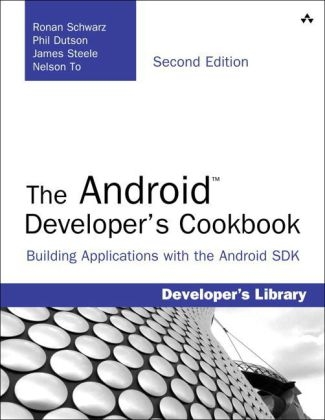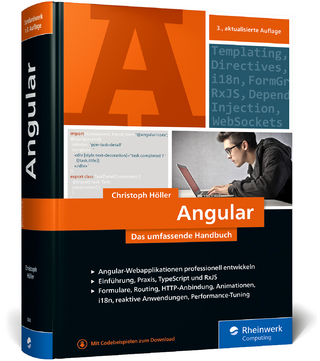
The Android Developer's Cookbook
Addison-Wesley Educational Publishers Inc (Verlag)
978-0-321-89753-4 (ISBN)
- Titel ist leider vergriffen;
keine Neuauflage - Artikel merken
This edition has been extensively updated to reflect the other Android 4.2.2 releases. You’ll find all-new chapters on advanced threading and UI development, in-app billing, push messages, and native development, plus new techniques for everything from accessing NFC hardware to using Google Cloud Messaging.
Proven modular recipes take you from the basics all the way to advanced services, helping you to make the most of the newest Android APIs and tools. The authors’ fully updated code samples are designed to serve as templates for your own projects and components. You’ll learn best-practice techniques for efficiently solving common problems and for avoiding pitfalls throughout the entire development lifecycle. Coverage includes
Organizing Android apps and integrating their activities
Working efficiently with services, receivers, and alerts
Managing threads, including advanced techniques using AsyncTasks and loaders
Building robust, intuitive user interfaces
Implementing advanced UI features, including Custom Views, animation, accessibility, and large screen support
Capturing, playing, and manipulating media
Interacting with SMS, websites, and social networks
Storing data via SQLite and other methods
Integrating in-app billing using Google Play services
Managing push messaging with C2DM
Leveraging new components and structures for native Android development
Efficiently testing and debugging with Android’s latest tools and techniques, including LINT code analysis
The Android™ Developer’s Cookbook, Second Edition, is all you need to jumpstart any Android project, and create high-value, feature-rich apps that sell.
Ronan “Zero” Schwarz, cofounder of OpenIntents, has built Android apps since 2007 and helped create SplashPlay and Droidspray–top Google Android Developer Challenge finalists. Phil Dutson is lead eCommerce developer for ICON Health and Fitness. He wrote Sams Teach Yourself jQuery Mobile in 24 Hours. James Steele, vice president of engineering at Sensor Platforms, focuses on helping app developers leverage user motion and context information more easily. Nelson To markets multiple apps at Google Play. He has worked on enterprise Android apps for Think Computer, Inc., AOL (AIM), Stanford University, and Logitech.
Preface xxi About the Authors xxv
Chapter 1: Overview of Android 1
The Evolution of Android 1
The Dichotomy of Android 2
Devices Running Android 2
Hardware Differences on Android Devices 6
Features of Android 10
Android Development 11
Software Development Kit (SDK) 12
Google Play 16
Managing Reviews and Updates 19
Alternatives to Google Play 20
Chapter 2: Application Basics: Activities and Intents 21
Android Application Overview 21
Activity Lifecycle 31
Multiple Activities 36
Chapter 3: Threads, Services, Receivers, and Alerts 51
Threads 51
Messages between Threads: Handlers 58
Alerts 63
Services 69
Broadcast Receivers 82
App Widgets 85
Chapter 4: Advanced Threading Techniques 89
Loaders 89
AsyncTasks 91
Android Inter-Process Communication 94
Chapter 5: User Interface Layout 109
Resource Directories and General Attributes 109
Views and ViewGroups 112
Text Manipulation 124
Other Widgets: From Buttons to Seek Bars 130
Chapter 6: User Interface Events 145
Event Handlers and Event Listeners 145
Advanced User Interface Libraries 168
Chapter 7: Advanced User Interface Techniques 177
Android Custom View 177
Android Animation 183
Accessibility 189
Fragments 191
Chapter 8: Multimedia Techniques 199
Images 199
Audio 206
Video 217
Chapter 9: Hardware Interface 221
Camera 221
Other Sensors 227
Telephony 231
Bluetooth 236
Near Field Communication (NFC) 243
Universal Serial Bus (USB) 248
Chapter 10: Networking 251
Reacting to the Network State 251
Using SMS 255
Using Web Content 263
Social Networking 275
Chapter 11: Data Storage Methods 287
Shared Preferences 287
SQLite Database 297
Content Provider 306
File Saving and Loading 312
Chapter 12: Location-Based Services 315
Location Basics 315
Using Google Maps 325
Using the Little Fluffy Location Library 337
Chapter 13: In-App Billing 343
Google Play In-App Billing 343
Chapter 14: Push Messages 349
Google Cloud Messaging Setup 3 49
Sending and Receiving Push Messages 351
Receiving Messages 353
Sending Messages 356
Chapter 15: Android Native Development 361
Android Native Components 361
Chapter 16: Debugging 371
Android Test Projects 371
Eclipse Built-In Debug Tools 377
Android SDK Debug Tools 380
Android System Debug Tools 390
Appendix A: Using the OpenIntents Sensor Simulator 395
Setting Up the Sensor Simulator 395
Adding the Sensor Simulator to an Application 398
Appendix B: Using the Compatibility Pack 401
Android Support Packages 401
Adding the Support Library to a Project 408
Appendix C: Using a Continuous Integration System 409
Appendix D: Android OS Releases 411
Cupcake: Android OS 1.5, API Level 3, Released April 30, 2009 411
Donut: Android OS 1.6, API Level 4, Released September 15, 2009 411
Eclair: Android OS 2.0, API Level 5, Released October 26, 2009 412
Froyo: Android OS 2.2, API Level 8, Released May 20, 2010 412
Gingerbread: Android OS 2.3, API Level 9, Released December 6, 2010 412
Honeycomb: Android OS 3.0, API Level 11, Released February 22, 2011 413
Ice Cream Sandwich: Android OS 4.0, API Level 14,Released October 19, 2011 413
Jelly Bean: Android OS 4.1, API Level 16, Released July 9, 2012 414
Index 417
| Erscheint lt. Verlag | 11.7.2013 |
|---|---|
| Verlagsort | New Jersey |
| Sprache | englisch |
| Maße | 180 x 228 mm |
| Gewicht | 712 g |
| Themenwelt | Mathematik / Informatik ► Informatik ► Netzwerke |
| Informatik ► Software Entwicklung ► Mobile- / App-Entwicklung | |
| Mathematik / Informatik ► Informatik ► Web / Internet | |
| Informatik ► Weitere Themen ► Smartphones / Tablets | |
| Technik ► Nachrichtentechnik | |
| ISBN-10 | 0-321-89753-6 / 0321897536 |
| ISBN-13 | 978-0-321-89753-4 / 9780321897534 |
| Zustand | Neuware |
| Haben Sie eine Frage zum Produkt? |
aus dem Bereich


